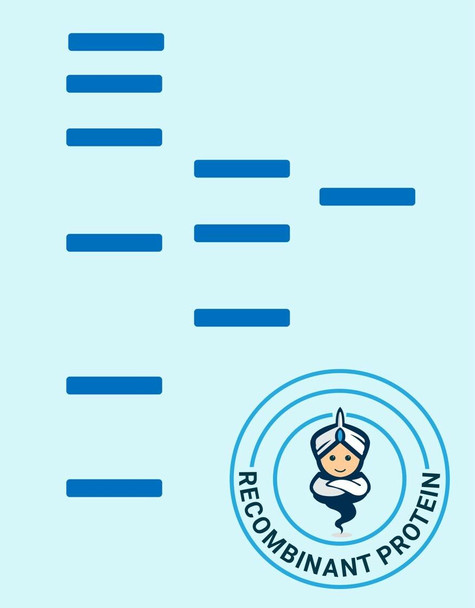Human CST9 Recombinant Protein (RPPB3295)
- SKU:
- RPPB3295
- Product Type:
- Recombinant Protein
- Species:
- Human
- Uniprot:
- Q5W186
Description
| Product Name: | Human CST9 Recombinant Protein |
| Product Code: | RPPB3295 |
| Size: | 20µg |
| Species: | Human |
| Target: | CST9 |
| Synonyms: | CLM, cystatin-9 (testatin), Cystatin-like molecule. |
| Source: | Escherichia Coli |
| Physical Appearance: | Sterile Filtered colorless solution. |
| Formulation: | The CST9 solution (1mg/ml) contains 20mM Tris-HCl buffer (pH 8.0), 0.4M Urea and 10% glycerol. |
| Stability: | Store at 4°C if entire vial will be used within 2-4 weeks. Store, frozen at -20°C for longer periods of time. For long term storage it is recommended to add a carrier protein (0.1% HSA or BSA).Avoid multiple freeze-thaw cycles. |
| Purity: | Greater than 90% as determined by SDS-PAGE. |
| Amino Acid Sequence: | MGSSHHHHHH SSGLVPRGSH MWCSEEEMGG NNKIVQDPMF LATVEFALNT FNVQSKEEHA YRLLRVLSSW REDSMDRKWR GKMVFSMNLQ LRQTVCRKFE DDIDNCPFQE SLELNNVRQG ISFPQVHSCG CCMGCGVGTG AADKAIPRDK GK |
CST9 belongs to the CRES (cystatin-related epididymal spermatogenic) subfamily. The CRES (cystatin-related epididymal spermatogenic) protein outlines a new subgroup in the family 2 cystatins of the cystatin superfamily. A few members are active cysteine protease inhibitors, however others have lost or possibly never developed this inhibitory activity. CST9 takes part in hematopoietic differentiation or inflammation and is expressed in heart, placenta, lung, liver, skeletal muscle and pancreas. CST9 is upregulated by LPS in several cancer cell lines, such as promyelocytic leukemia (HL-60) and myelomonocytic leukemia.
CST9 Human Recombinant produced in E.coli is a single, non-glycosylated polypeptide chain containing 152 amino acids (29-159) and having a molecular mass of 17.2 kDa.CST9 is fused to a 21 amino acid His-tag at N-terminus & purified by proprietary chromatographic techniques.
| UniProt Protein Function: | CST9: May play a role in hematopoietic differentiation or inflammation. Belongs to the cystatin family. |
| UniProt Protein Details: | Protein type:Secreted; Secreted, signal peptide Chromosomal Location of Human Ortholog: 20p11.21 Cellular Component: extracellular region Molecular Function:cysteine protease inhibitor activity |
| NCBI Summary: | The cystatin superfamily encompasses proteins that contain multiple cystatin-like sequences. Some of the members are active cysteine protease inhibitors, while others have lost or perhaps never acquired this inhibitory activity. There are three inhibitory families in the superfamily, including the type 1 cystatins (stefins), type 2 cystatins and the kininogens. The type 2 cystatin proteins are a class of cysteine proteinase inhibitors found in a variety of human fluids and secretions, where they appear to provide protective functions. The cystatin locus on chromosome 20 contains the majority of the type 2 cystatin genes and pseudogenes. This gene is located in the cystatin locus and encodes a secreted protein that may play a role in hematopoietic differentiation or inflammation. [provided by RefSeq, Jul 2008] |
| UniProt Code: | Q5W186 |
| NCBI GenInfo Identifier: | 226529477 |
| NCBI Gene ID: | 128822 |
| NCBI Accession: | NP_001008693.2 |
| UniProt Secondary Accession: | Q5W186,Q8TD53, B2RP76, |
| UniProt Related Accession: | Q5W186 |
| Molecular Weight: | 18,135 Da |
| NCBI Full Name: | cystatin-9 |
| NCBI Synonym Full Names: | cystatin 9 (testatin) |
| NCBI Official Symbol: | CST9�� |
| NCBI Official Synonym Symbols: | CLM; CTES7A�� |
| NCBI Protein Information: | cystatin-9; cystatin-like molecule |
| UniProt Protein Name: | Cystatin-9 |
| UniProt Synonym Protein Names: | Cystatin-like molecule |
| Protein Family: | Cystatin |
| UniProt Gene Name: | CST9�� |
| UniProt Entry Name: | CST9_HUMAN |








